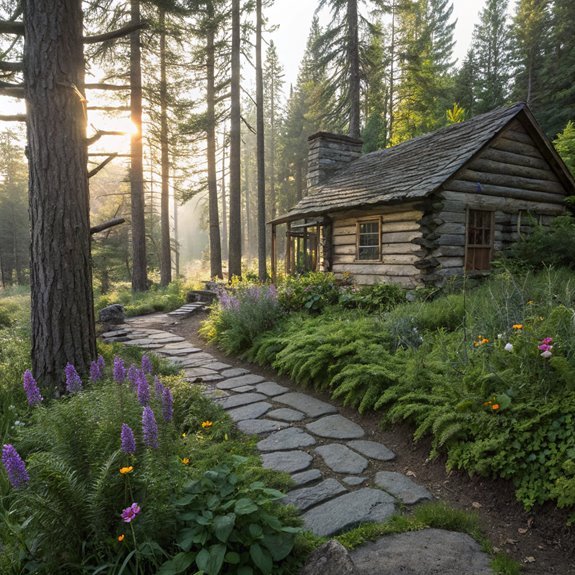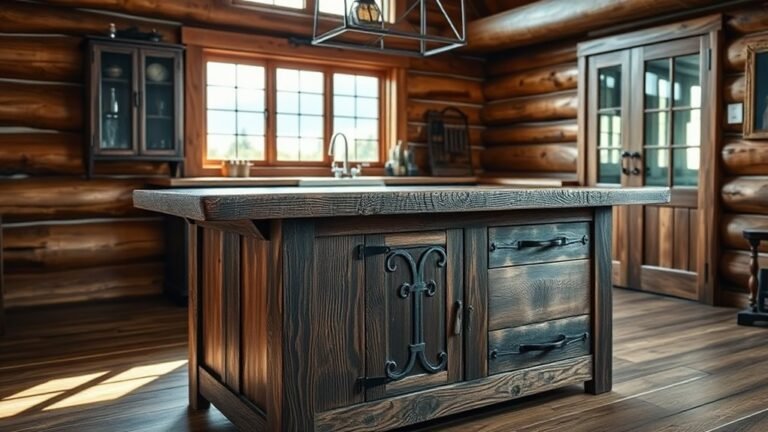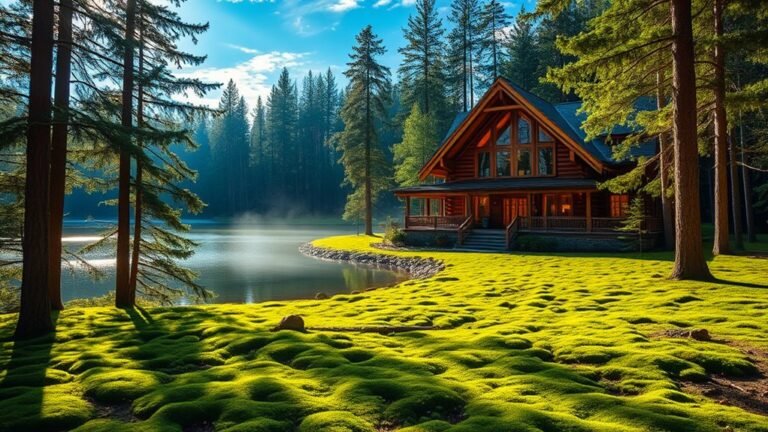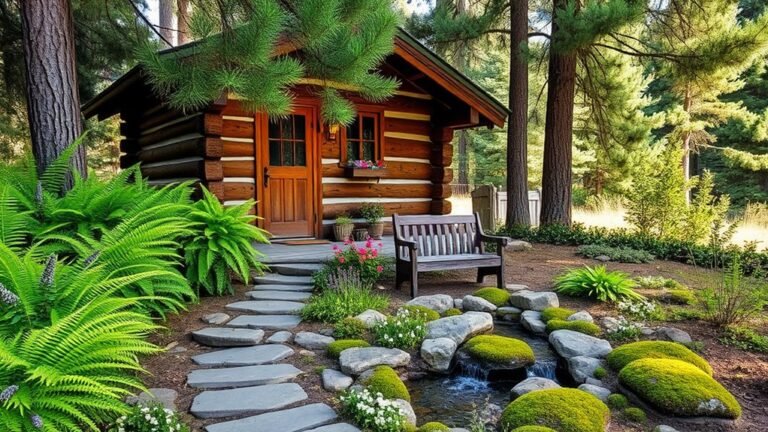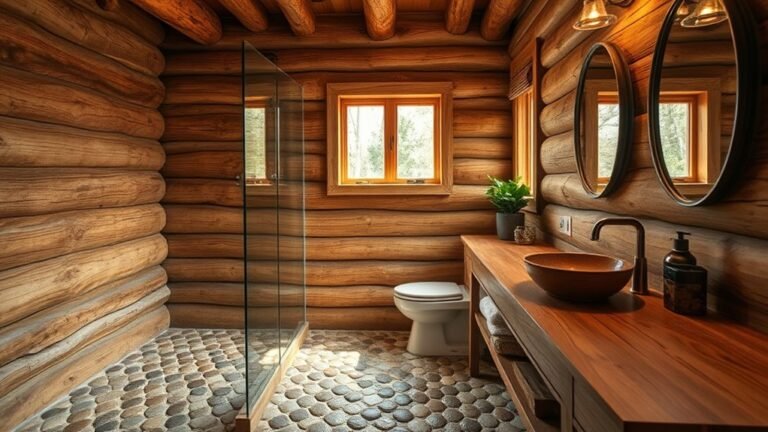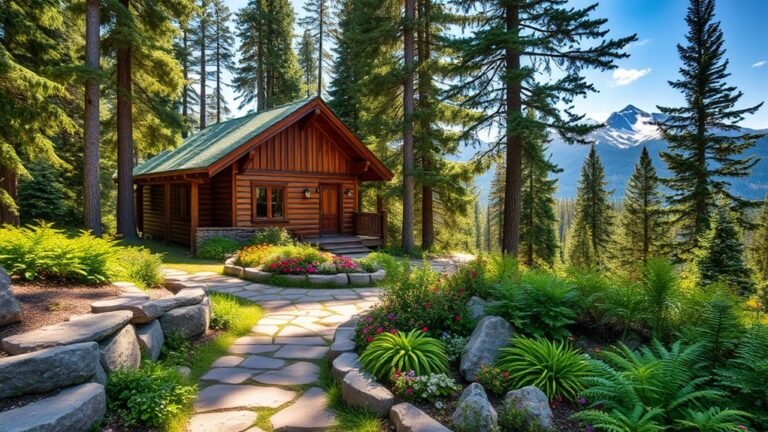19 Log Cabin Landscaping With Trees for Shade
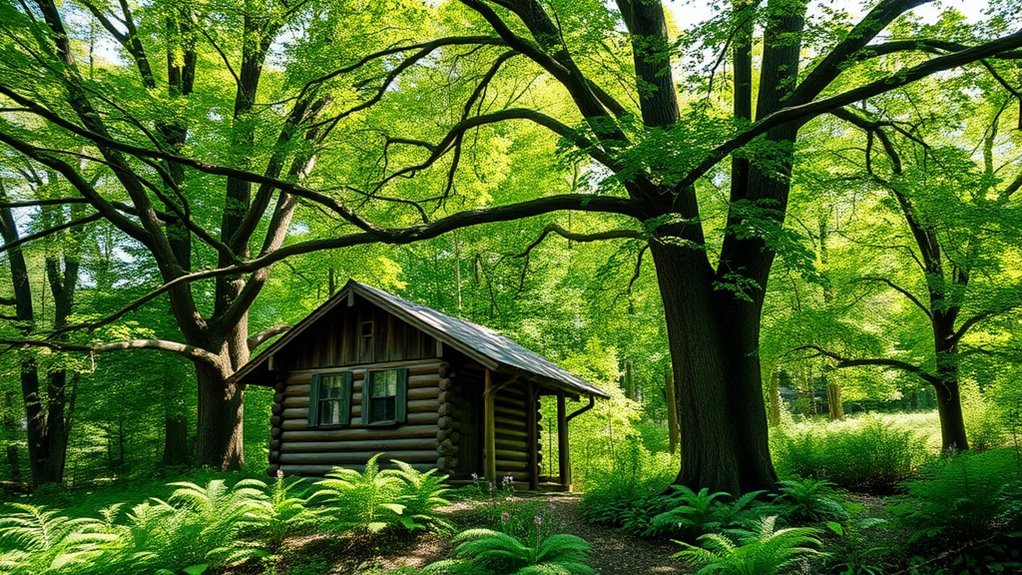
Strategically placed trees can cut energy costs by up to 25%, making them a smart choice for log cabin landscaping. Selecting the right types and arrangements not only adds visual appeal but also provides comfort during hot summer months.
To maximize both functionality and beauty, carefully consider your tree selection and layering strategy.
Choosing the Right Trees
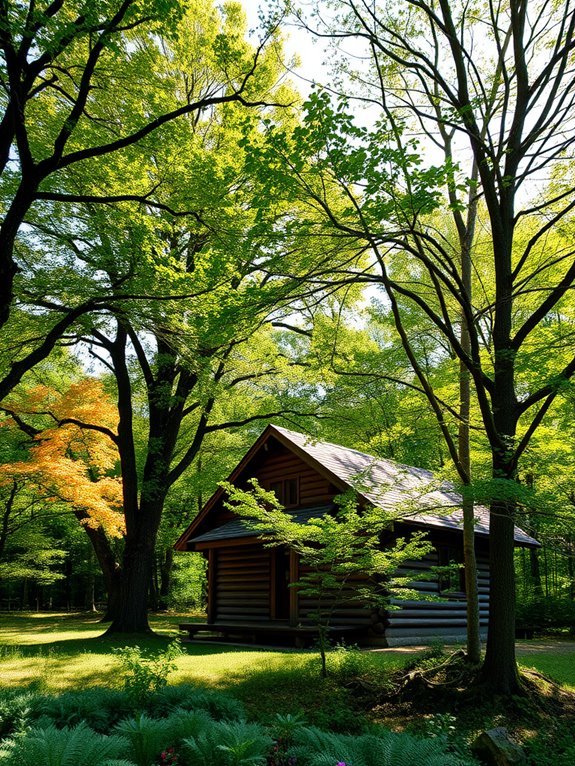
Choosing the right trees for your log cabin landscaping is crucial for creating a harmonious environment.
Picture a serene space where sunlight filters through the leaves, and branches rustle gently. Opt for trees that enhance your cabin’s rustic charm and provide shade.
Consider the mature size of the trees to avoid overshadowing your cabin. Think about seasonal changes; evergreens add life in winter, while deciduous trees offer vibrant fall colors.
A mix of tree varieties adds texture and interest.
Factor in maintenance needs—some trees require extensive care. Select trees that suit your lifestyle, allowing you to enjoy your landscape without constant upkeep.
When selecting decor for your cabin, earthy tones like browns, greens, and grays can complement the natural beauty of your trees.
With the right choices, your log cabin will become a woodland paradise. Happy planting!
Native Trees for Your Area
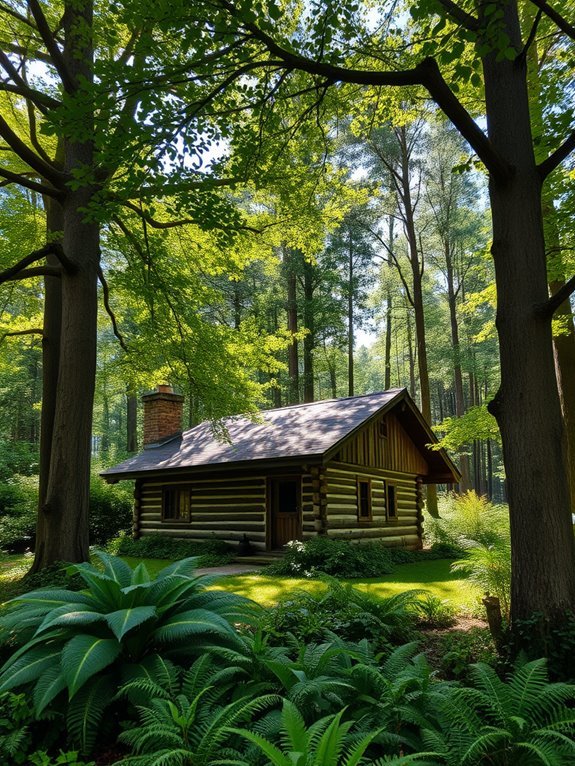
Choosing native trees for your area benefits local wildlife and ensures thriving landscaping with minimal effort.
These trees are well-adapted to your climate, soil, and pests, needing less water and fewer chemicals. They create habitats for birds and butterflies, enhance air quality, and prevent soil erosion.
Planting native trees like oaks or dogwoods not only offers natural shade but also makes your yard lively and eco-friendly.
Picking the right trees can be an enjoyable adventure—explore local nurseries or parks for inspiration.
Happy planting!
Deciduous vs. Evergreen Trees
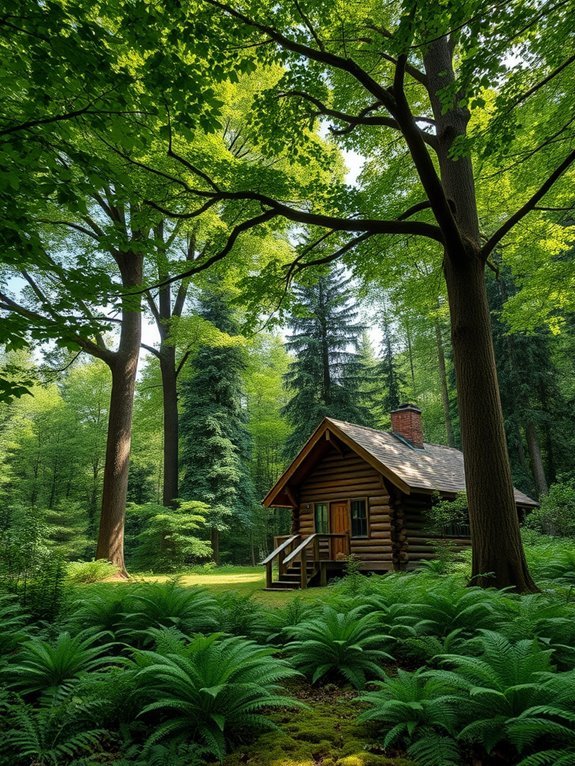
Understanding the differences between deciduous and evergreen trees can influence your landscaping choices.
Deciduous trees, like oaks and maples, lose leaves in fall, offering vibrant colors before winter and ample shade in warmer months. As leaves fall, more sunlight brightens winter days.
Evergreen trees, like pines and spruces, retain needles year-round, providing consistent shade and privacy. They also serve as a backdrop for seasonal decorations.
Consider whether you prefer vibrant fall foliage or steady greenery. Both types add unique flair, and mixing them offers the best of both worlds.
Happy planting!
Layering for Visual Interest
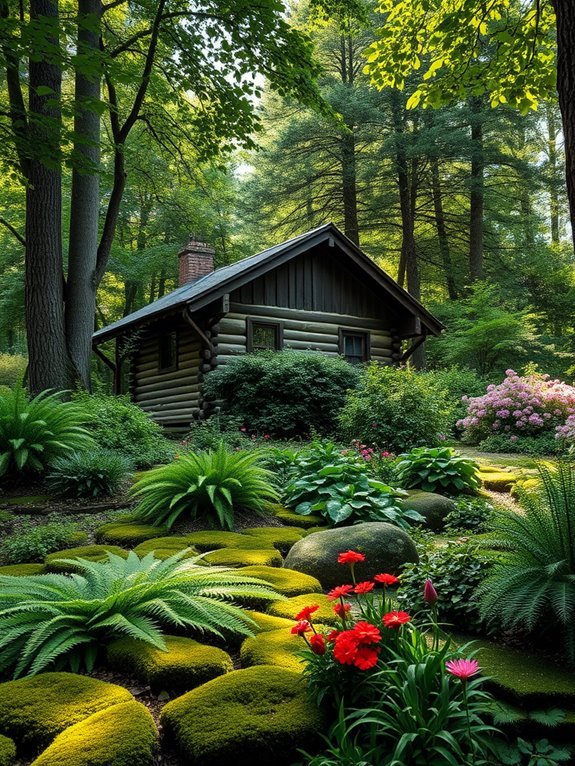
Enhance your log cabin’s landscape by layering different tree heights and types for visual interest. Start with tall trees like pines and oaks at the back for a spacious feel. Add mid-sized trees in front for shade and play areas, then finish with smaller trees or shrubs at the front. Mix evergreen and deciduous varieties for year-round vitality. Consider colors and textures to create a harmonious look that complements your cabin. Incorporate earthy elements such as wooden furniture and natural materials to enhance the rustic charm of your cabin’s outdoor space. Grab your gardening gloves, plant, and transform your landscape into a picturesque retreat!
Creating a Natural Canopy
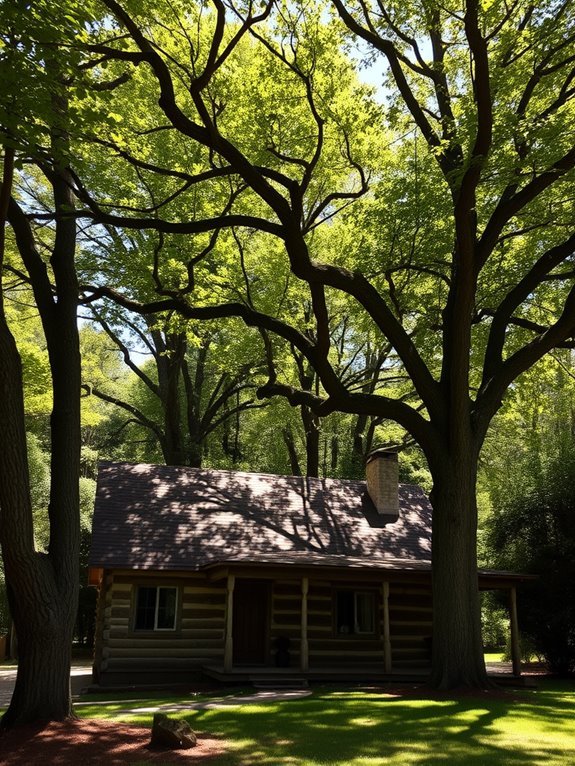
Layer different tree heights for visual interest and enhance your log cabin landscaping with a natural canopy.
Imagine stepping outside to a lush overhead shelter of leaves—nature’s cool umbrella. Choose tall, wide trees like oaks or maples for shade, mixed with mid-height trees like dogwoods or birches for texture and light filtration.
Maintain balance; too many tall trees can make your cabin feel cave-like. Consider spacing to avoid overcrowding.
Reflect on seasonal changes for vibrant autumn colors. Grab your shovel—you’re just a few trees away from creating an outdoor paradise.
Incorporating Flowering Trees
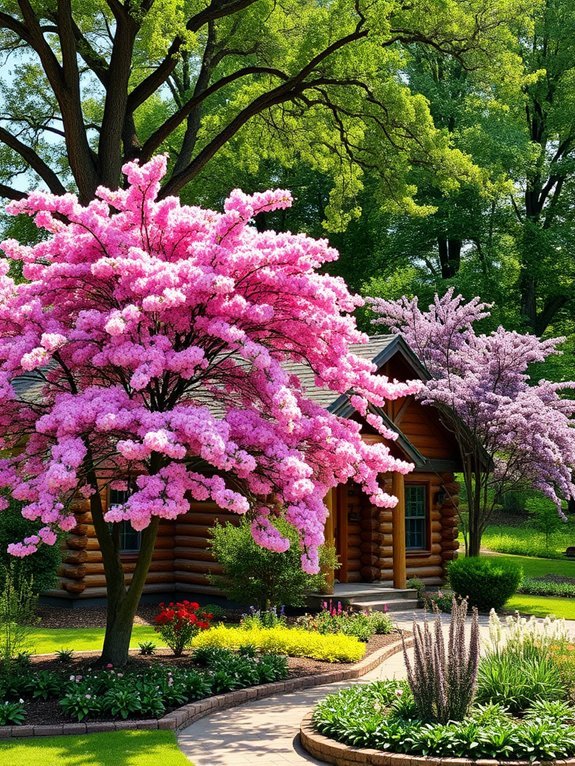
Incorporate flowering trees into your log cabin landscape for bursts of color and delightful fragrances year-round.
Picture vibrant cherry blossoms or cheerful forsythia greeting you outside your cabin, attracting pollinators like bees and butterflies.
Plant dogwoods or magnolias for stunning spring and summer blooms, making them the yard’s centerpiece with their unique shapes and textures.
In fall, these trees transform your landscape with reds, oranges, and yellows.
Enjoy coffee on your porch, surrounded by a kaleidoscope of colors and the sweet scent of blossoms.
Fruit Trees for Added Beauty
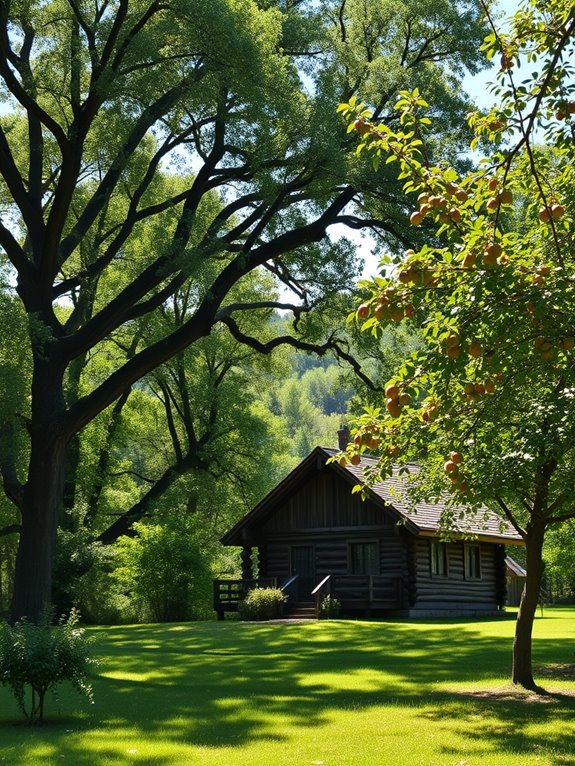
Enhancing your log cabin landscape with fruit trees not only adds beauty but provides delicious harvests. Imagine picking apples, peaches, or cherries right from your yard—a personal mini grocery store!
Fruit trees come in various sizes. Dwarf varieties suit small spaces, while full-sized trees offer ample shade and tasty fruit. A mix of trees offers a visual feast: spring blossoms, summer greenery, and fall colors, while attracting pollinators like bees and butterflies.
Consider maintenance; while they require care, the homegrown fruit is worth it. Grab your gardening gloves and dig in!
You’ll enjoy both a beautiful landscape and the literal sweet taste of success.
Trees for Privacy Screens
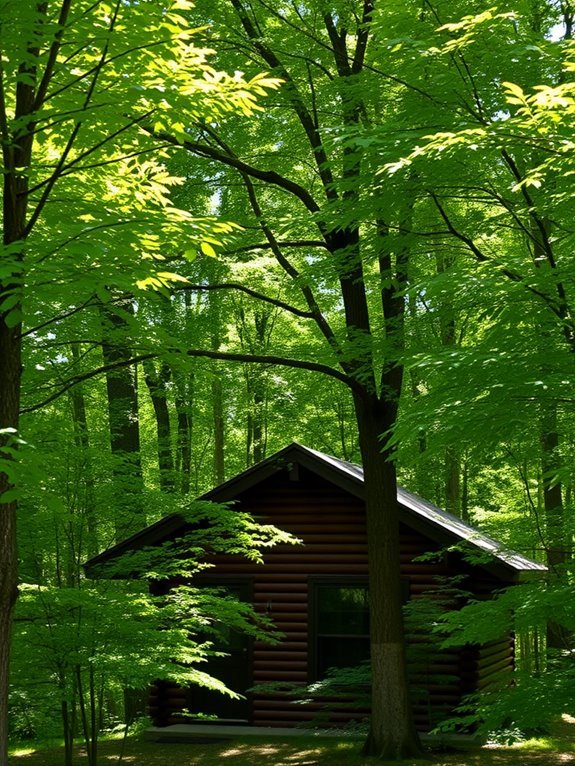
Create a serene retreat around your log cabin with trees for privacy screens.
Evergreens like Arborvitae or Spruce offer tall, dense, year-round coverage without shedding leaves in winter. For a colorful option, consider flowering trees like Redbud or Dogwood, which provide both privacy and stunning spring blooms.
To enhance your cabin’s interior, consider incorporating rustic decor elements that complement the natural vibe of your landscape. Plant in groups and mix varieties for a cozy, woodland vibe. Give trees enough space to grow, ensuring a beautiful, private area perfect for relaxing or gardening.
Start planting and enjoy your leafy fortress!
Selecting Trees for Small Spaces
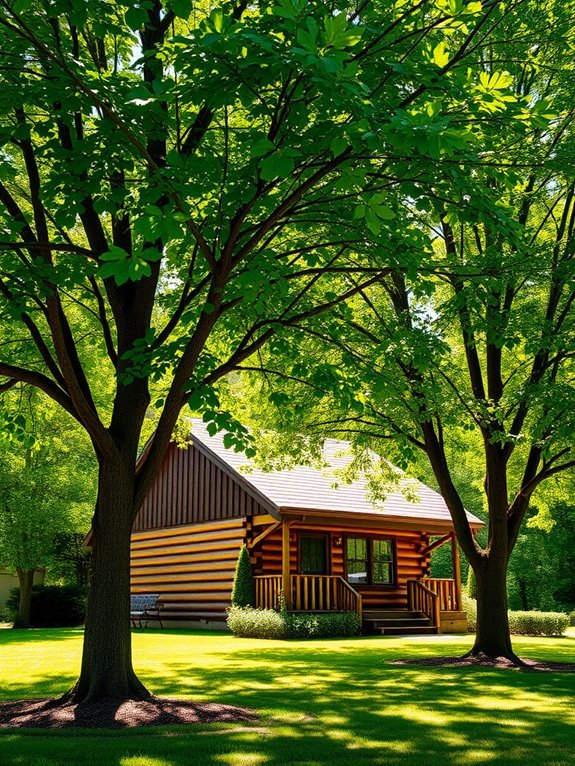
For small spaces around your log cabin, choose compact yet appealing trees. Dwarf varieties or slow-growing species like Japanese maple and flowering dogwood add color without dominating your yard.
Consider the height and spread; tall, narrow trees can provide shade along pathways without blocking views. Evergreens like dwarf Alberta spruce offer year-round greenery in limited spaces.
Assess soil and sunlight conditions to pick suitable trees, and mix in shrubs or perennials for a lush, layered landscape.
Using Trees as Focal Points
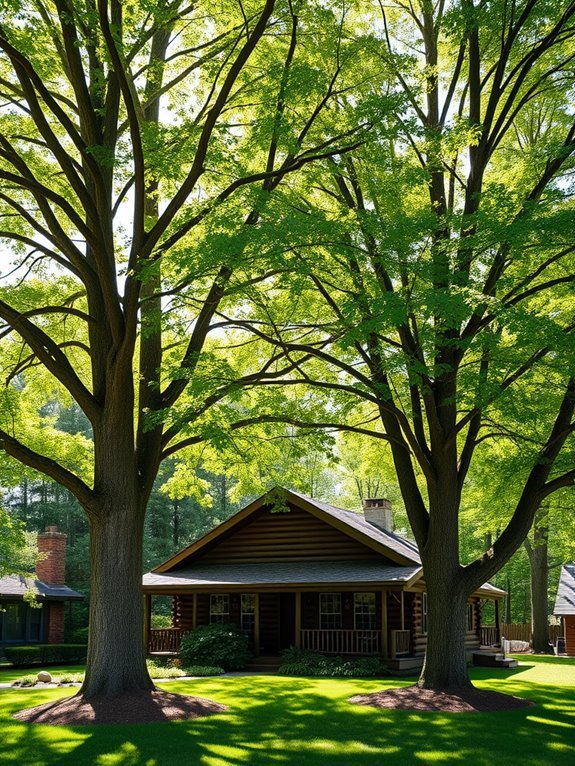
Trees can be captivating focal points in your log cabin landscape, providing shade and character.
They can transform your yard into a serene retreat for relaxation or entertainment.
Here are four ideas to enhance your tree choices:
- Unique Shapes: Choose trees with distinctive forms, like twisted branches or weeping canopies, for visual interest.
- Colorful Foliage: Select trees with seasonal color changes, such as vibrant reds in fall or fresh greens in spring, to keep your landscape lively.
- Layering Heights: Use trees of varying heights to add depth and create a dynamic appearance.
- Highlight with Lighting: Illuminate your focal trees at night with outdoor lighting to create a magical atmosphere.
Grouping Trees for Impact
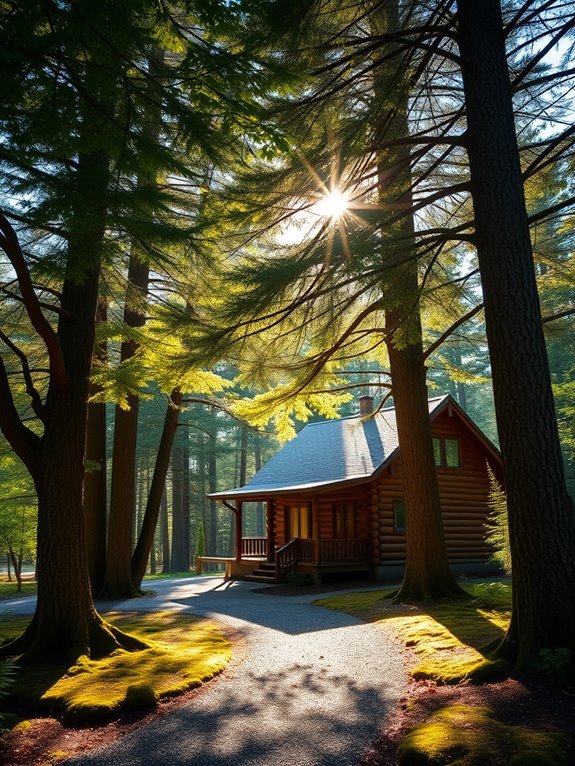
Enhance your log cabin landscape by grouping trees to create a natural canopy and a cozy retreat. A mix of tall pines and colorful maples can transform an ordinary yard into an extraordinary one.
You don’t need to be a landscape architect—just follow your instincts!
Consider tree height, shape, and color for a dynamic look. Grouping trees not only adds depth and texture but also provides shade, making your cabin more inviting in summer.
Plus, it attracts wildlife like birds and butterflies, turning your space into a nature hub.
So, grab your shovel, select your favorite trees, and start planting. You’ll be amazed at the impact!
Happy landscaping!
Designing Pathways With Trees
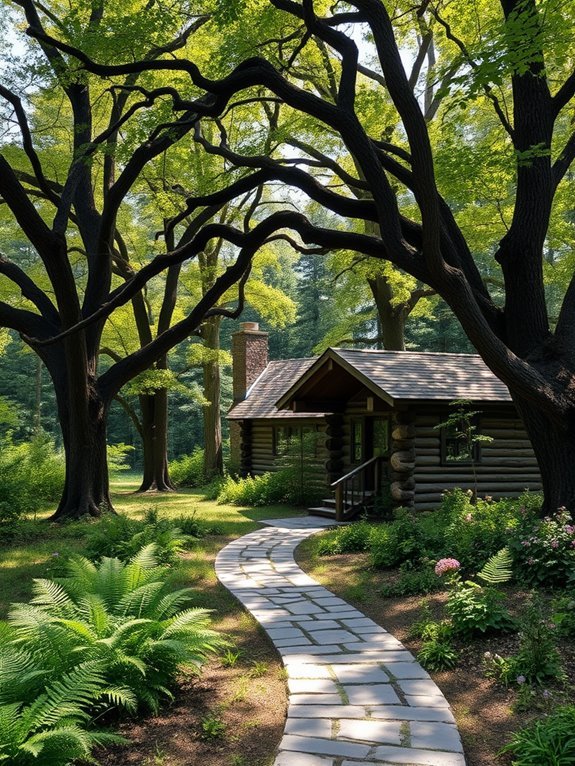
When designing your log cabin landscape, consider how tree-lined pathways can guide visitors through your outdoor space.
Imagine strolling along a charming trail, shaded by trees that add a sense of adventure.
Here are four tips for creating delightful pathways with trees:
- Choose the Right Trees: Opt for smaller ornamental trees that enhance beauty without overpowering the path.
- Vary the Spacing: Space trees to allow growth and create an inviting, leisurely stroll.
- Incorporate Seating: Add benches or boulders for rest and enjoyment of the scenery.
- Add Lighting: Use strategically placed lights to enhance nighttime charm and create a magical atmosphere.
These ideas will make your pathways a highlight of your log cabin landscaping, offering an enchanting walking experience!
Utilizing Vertical Space
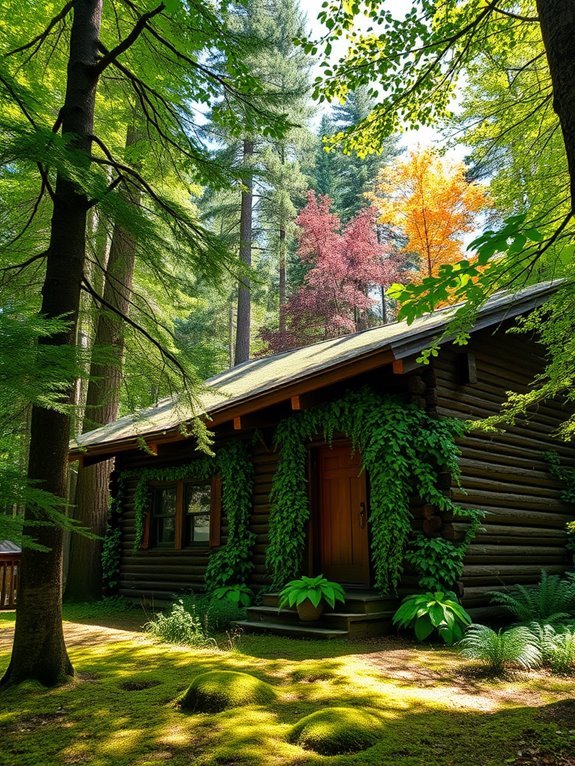
When designing your log cabin landscape, utilize vertical space for a stunning visual effect. Vertical gardening adds dimension and interest with trellises, archways, and climbing plants like sweet peas or morning glories.
Hanging planters are ideal for small spaces, adding color above eye level, and layered plants create lush, tiered gardens. Consider a vertical garden structure filled with herbs or flowers for functionality and as a conversation starter.
A garden gnome perched high adds whimsy. Use fences, walls, and trees to display plants, transforming your landscape into a charming vertical wonderland with creativity.
Trees for Wildlife Habitat
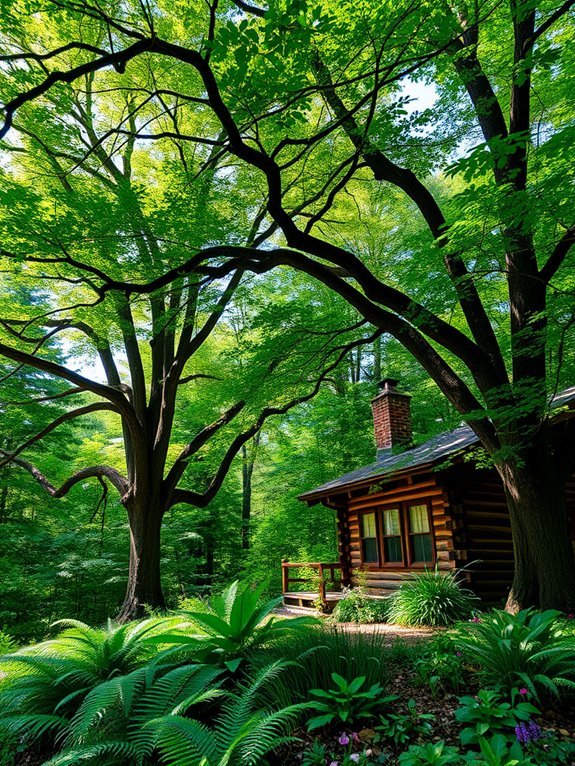
Incorporating trees into your log cabin landscape enhances aesthetics and creates vital habitats for wildlife. By planting trees, you provide shade and invite birds, butterflies, and small mammals into your backyard.
Here are four benefits of trees for wildlife habitat:
- Nesting Sites: Trees offer nooks for birds to nest and raise young, adding morning chirps to your surroundings.
- Food Sources: Trees produce nuts, seeds, and fruits, attracting squirrels, chipmunks, and deer.
- Shelter: Dense canopies and thick trunks protect wildlife from predators and harsh weather.
- Biodiversity: Diverse tree populations support various species, fostering a vibrant ecosystem.
Seasonal Color Changes
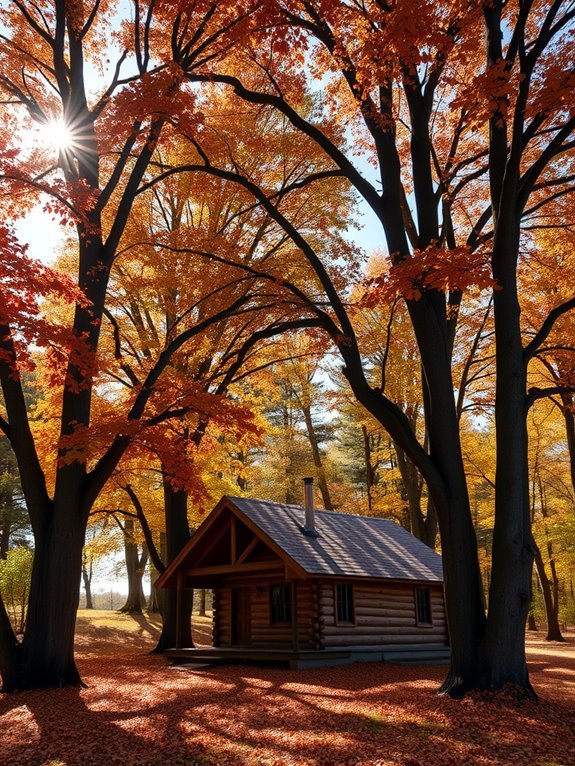
Choosing the right trees for your log cabin landscape offers a stunning seasonal transformation.
In spring, enjoy the burst of blossoms like nature’s confetti.
Summer brings lush, inviting greenery ideal for hammock relaxation.
Fall dazzles with vibrant reds and oranges, turning your yard into a colorful masterpiece perfect for a cider stroll.
Winter showcases bare branches against snow, a striking reminder of beauty in every season.
Your ever-changing landscape will surely captivate the neighborhood!
Low-Maintenance Tree Options
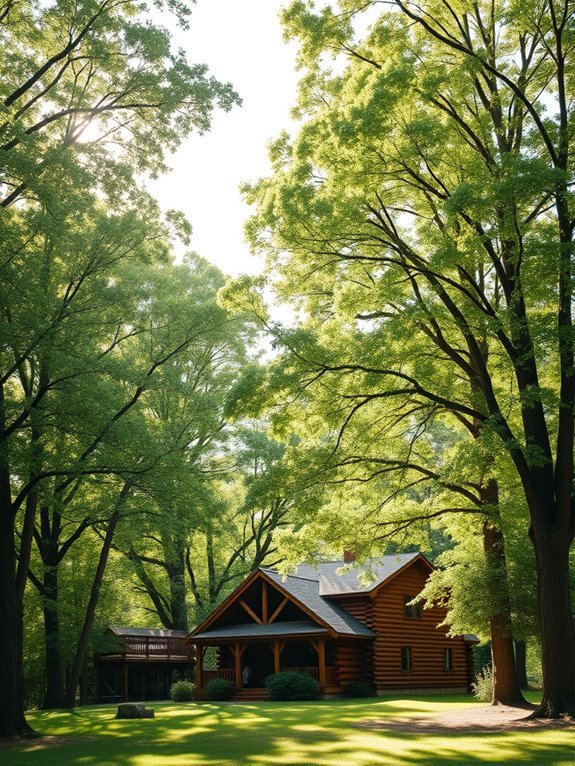
For a beautiful landscape with minimal upkeep, opt for low-maintenance trees around your log cabin.
These trees offer shade, visual interest, and a cozy atmosphere without constant effort.
Here are four excellent options:
- Eastern Red Cedar: Drought-resistant and aromatic, it also attracts birds for a natural soundtrack.
- Autumn Blaze Maple: Vibrant fall colors with little care required—just enjoy the transformation.
- Black Gum: Thrives in various soils, resistant to pests, and offers stunning fall colors.
- Serviceberry: Features lovely spring blossoms and delicious berries—plant and let it flourish.
These choices mean less work and more beauty in your yard.
Happy planting!
Mulching Around Trees
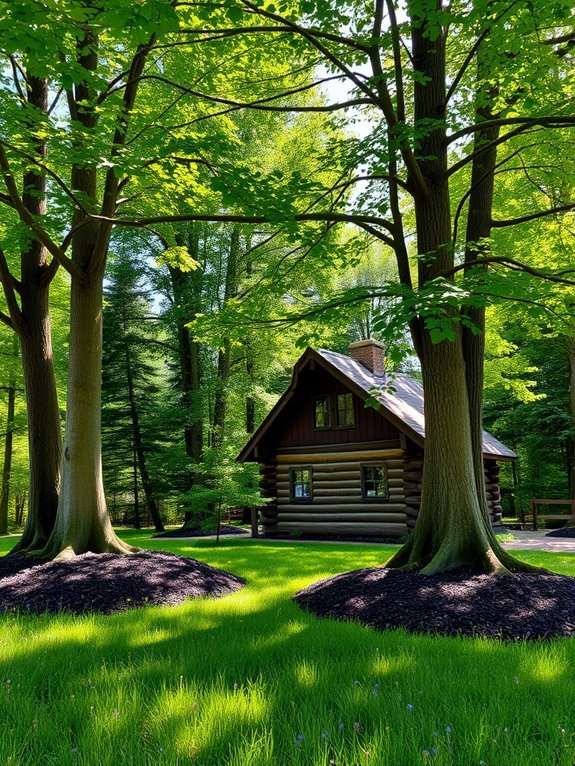
Mulching trees boosts their health, enhances appearance, and reduces maintenance. By insulating roots, mulch keeps them warm in winter, cool in summer, and retains moisture, reducing watering needs.
Apply a three-inch layer evenly around the tree base, but keep it a few inches from the trunk to avoid rot. Use materials like wood chips, straw, or shredded leaves based on preference and availability.
Besides health benefits, mulch adds a polished look to landscaping. Pamper your trees with this simple step for a beautiful, low-maintenance yard. Happy mulching!
Combining Trees With Shrubs
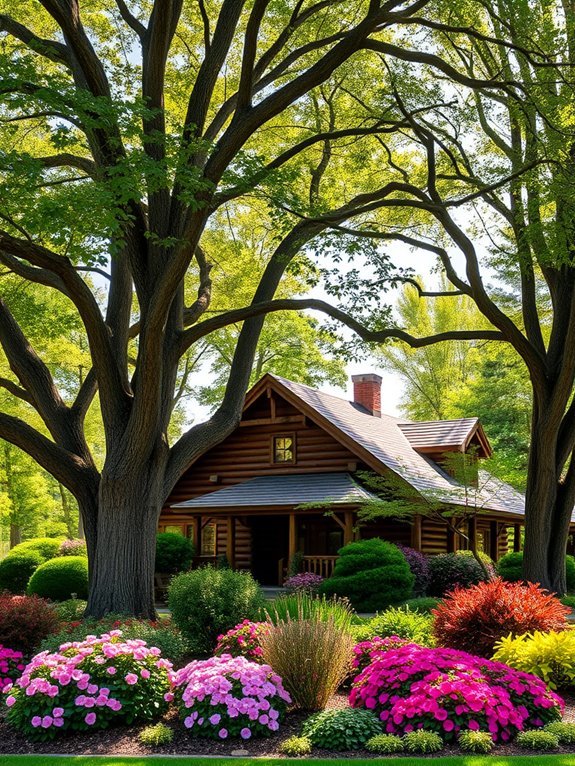
Combining trees and shrubs enhances visual appeal and creates a diverse ecosystem in your landscape.
This mix offers a variety of shapes, colors, and textures, showcasing your gardening skills to friends and family.
Here are four reasons to combine trees with shrubs:
- Shade and Shelter: Trees provide shade, while shrubs protect smaller plants and wildlife.
- Seasonal Interest: Different plants bloom at various times, keeping your landscape lively year-round.
- Soil Health: Shrubs prevent soil erosion and improve soil quality by adding organic matter.
- Wildlife Habitat: Trees and shrubs attract birds, butterflies, and beneficial insects, creating a vibrant ecosystem.
Enhancing Views With Trees
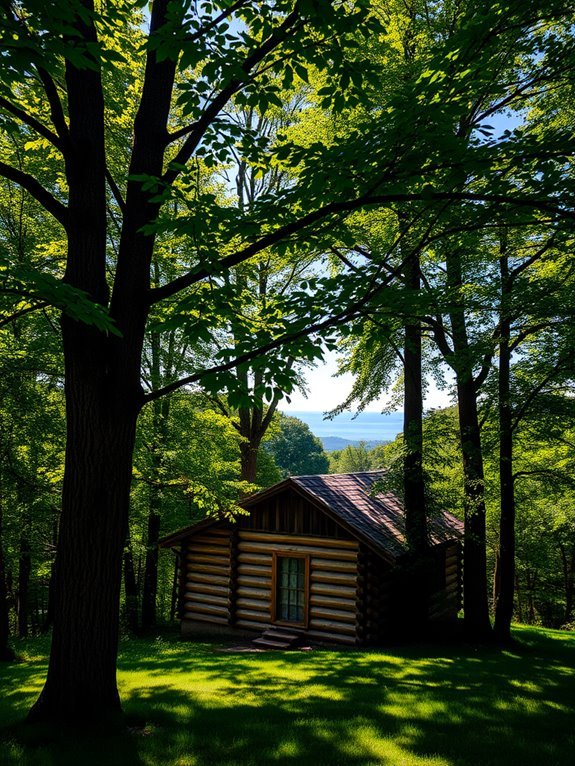
Strategically placing trees can significantly enhance landscape views. Imagine stepping outside your log cabin to a vibrant scene framed by lush trees instead of a plain expanse—nature’s picture frame.
Consider where you want to draw the eye, like a beautiful pond or distant mountain view. Use taller trees for a natural backdrop or shorter ones to highlight features. For a whimsical touch, cluster trees in odd numbers for an inviting, organic feel.
Remember seasonal changes: bright autumn leaves or summer’s green shades can create dynamic vistas year-round.
Additionally, trees provide privacy, creating a secluded oasis. Grab a shovel, channel your inner landscape artist, and let trees transform your views!
Frequently Asked Questions
What Is the Best Time to Plant Trees for Shade?
The best time to plant trees for shade is in early spring or fall. You’ll guarantee better root establishment and growth. Just make certain to take into account your local climate and tree type for ideal results.
How Can I Maintain Tree Health in My Landscape?
Think of your trees as vibrant dancers in a garden ballet. To maintain their health, water them regularly, mulch around their roots, prune dead branches, and watch for pests. They’ll flourish under your care!
Are There Any Trees That Attract Beneficial Insects?
Yes, certain trees attract beneficial insects. For example, willows and black locusts provide food for pollinators. Planting these trees in your landscape can enhance biodiversity and support a healthy ecosystem, benefiting your overall garden health.
How Do Trees Affect Property Value?
Studies show homes with mature trees can sell for 10-15% more. Trees enhance curb appeal, provide shade, and improve air quality, making your property more desirable. You’ll appreciate the long-term value they add.
What Are the Best Trees for Windy Areas?
In windy areas, you’ll want to choose trees like Eastern Red Cedar or Black Hills Spruce. These species are sturdy and resilient, helping to protect your property while adding beauty to your landscape.
Conclusion
Choosing the right trees for your log cabin not only adds shade but also invites nature into your backyard. A single mature tree can absorb about 48 pounds of carbon dioxide annually, acting as a natural air purifier. Embrace layers of greenery and mix in shrubs to create a cozy, wildlife-friendly haven. Happy landscaping!

